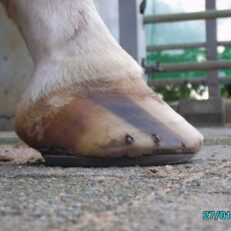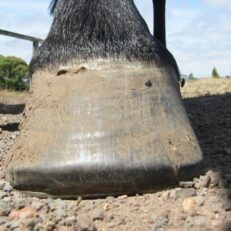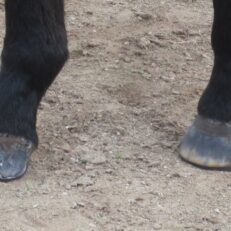BREAKOVER refers to that moment when the coronary band at the front of the hoof is perpendicular to the ground and the point at which the hoof is then able to leave the ground in its flight upwards and forwards.
Long toes delay the breakover, while short toes speed up the breakover; the correct breakover is as nature will dictate for each correctly prepared and balanced hoof.
At the moment it would seem that ‘Breakover Management’ is the latest buzzword to hit the world of farriery in Australia and probably everywhere else on the planet, and one would think that to be aware of the need to understand the importance of it, we should be able to avoid any chance of it becoming a problem. Surely if, as hoof care professionals, we truly know and practise correct hoof preparation and balance, there would be no need to ever consider it to be a problem because it could not exist.
There are so many differing opinions on what the correct breakover should be, and this is evident by the number of machine made shoes that all claim to assist in resolving the problem; in fact they are all only bandaids and if used for any length of time they do cause other problems. Because the bevelled leading edge of the ‘breakover’ shoe is set back behind the true leading edge of the hoof, this causes the hoof to leave the ground early, and to move in a higher arc, which causes the hoof to land much too early – in other words the shoe shortens the horse’s stride.
This problem has always been about the cause and effect of long toe/low heel condition of the hoof. We all know that the horse with those long sloping pasterns will always be inclined to develop the long toe/low heel condition quicker than others which have a more upright conformation, so to maintain soundness its hoof care has to be re-done perhaps every 21 days, and to do this all the team have to be on the same wave length (ie the owner, the trainer and the farrier). Invariably this doesn’t happen and the toes do get too long with the effect being delayed breakover which leads to forging, over reaching and strained tendons, and results in the end use of a shoe with built in breakover management.
There are some instances where we do need to shorten and square the toes but they are few and far between and it is usually only needed to help rehabilitate an injury. Generally short toes and high heels will cause early breakover but will also shorten the stride and result in bruised heel buttresses from concussion.
If your farrier feels the need to go down the path of fitting breakover enhanced shoes to your horse, ask him why, and consider if there is a clear understanding of the resulting effect that these shoes will have on the horse.
Here are a few basic principles about hoof care which have never changed and will never change – if you stick to applying these principles then you won’t have any problems with the current fad called ‘breakover management’.
- Anything we do which alters the shape of the leading edge of the hoof contrary to shape of the normal coronary band will alter the stride of the horse.
- Most hoof problems are caused by long toes.
- Most long toes are caused from lack of proper sole preparation, from the creeping toe syndrome and from not observing the true road map in the bottom of the hoof.
- A correctly prepared hoof, to be shod or unshod, should measure equally to the toe and heel from a centre point of balance which is 19mm behind the active tip of the frog.
- A flare anywhere in the hoof is your greatest enemy.
The centre point of balance has always been considered as being at the lowest point of the coffin joint, which in the correctly balanced hoof will be 19mm behind the clean active tip of the frog.
It may appear to some readers that I am against change; however those who know will also know the resulting folly when we go against that which Mother Nature has so superbly designed. The correct road map and reference points in the bottom of the hoof have always been there, but sadly so many of today’s hoof care providers don’t observe these simple basic principles when setting a horse up for either unshod or shod hoof preparation.
The correct breakover is achieved when the hoof is correctly balanced and results in the hoof leaving the ground when the coronary band at the point above the toe is perpendicular to the ground.
It appears that if we are again revisiting the issue of breakover management; it is a result of developing poor habits in hoof preparation, or perhaps we just don’t understand how to balance the hoof.
If the hoof preparation is correct there is no need to fit anything except a standard shaped shoe; however if the hoof is out of balance, then fitting shoes which have squared toes, rolled toes or ‘breakover enhanced design’ is only a bandaid measure and does not solve the problem. The answer is to remember the KISS PRINCIPLE (Keep it Simple, Stupid, or if you prefer, Keep it Simple, Sweetheart) and stick to the basics.



